Jan 26, 2024
A Guide to Capacity and Travel
You worked hard to buy the boat of your dreams. When you finally get the time to enjoy it, you don’t want to waste time getting it into the water. That is why so many waterfront owners choose to purchase boat lifts to store their vessel on site. Image the convenience of being in the water in minutes, while also keeping your boat safe and clean.
In order to achieve this, it’s important you choose the right boat lift to ensure the safety and longevity of your vessel. This guide will explore the key factors to consider when selecting a boat lift.
Understanding Capacity
Dry Weight vs. Operating Weight:
The first question you’ll need to answer when looking for a boat lift is, “What is the weight of your boat?” Your first thought will be to check your boats specifications, but there are many factors that contribute to your boats actual weight that are not listed in your boats specifications. The dry weight listed for boats often excludes outboard motors, fuel, fluids, gear, and accessories. You will need to consider the combined weight of these additional items when choosing lift capacity.
- Adding a 20% buffer to the total weight provides a safe margin for unforeseen variations.
- Overestimating capacity is wise if you plan to upgrade to a heavier boat in the future.
People and Cargo:
We know your time is limited and you want to spend as little time getting onto the water as possible. Storing your gear right on the boat is one of the biggest advantages of having your boat stored on site. You may not realize how much additional weight even the most typical items can add to your vessel. Now add a passenger or two. As you board your boat, you want to ensure easy access, especially for those who might not get around as easily anymore. To safely do this, you want to make sure you have taken these extra pounds into account.
- As per manufactures, boat lifts are not meant to carry people while in operation. Be sure to load and unload passengers with minimal time spent on the lift.
- As per manufactures, pontoon boats are not suitable as recreational decks while on the lift. With the proper increase in capacity, you could feel safer enjoying your boat even when it’s docked.
- Overloading the lift can cause serious injuries, and damage to both the boat and the lift itself.
Understanding Travel
The travel of a boat lift refers to the distance from its lowest position to its highest position. When the lift is in its highest position, you want to make sure the keel of your boat is high enough out of the water to avoid wave action. At its lowest position, you want to make sure you have enough water depth to freely float your boat off the lift.
Wave Action:
- Areas with strong waves necessitate a lift that elevates your boat sufficiently.
- Some lifts offer extended lifting ranges for optimal clearance in challenging conditions.
- Specific brands allow you to move small watercrafts away from the water entirely.
Water Depth:
- Knowing your water depth is crucial for selecting the appropriate lift type.
- Every body of water has daily and seasonal fluctuations, make sure you know the highs and the lows of your particular body of water.
- Shallow water may require a lift specifically designed for low water conditions.
- The lift’s minimum depth requirement needs to accommodate the draft of your boat.
Popular Boat Lift Options
Everyone’s needs are unique to their slice of paradise and the equipment they use. That’s why we have partnered with the industries top boat lift manufactures, so that we can provide a boat lift solution that fits your needs.

Offers cable and hydraulic lifts with capacities ranging from 1,200 lb to 12,500 lb.
Cable lifts have a 5’6” lifting range and require 12″ of water depth plus the boat’s draft.
Hydraulic lifts offer up to 5’ of lifting range and require 18″ of water depth plus the boat’s draft.

Offers hydraulic lifts with capacities ranging from 2,000 lb to 30,000 lb.
Hydraulic lifts have a maximum 6’6” of lifting range, ideal for areas with strong waves.
Lifts can be adapted for extremely low water levels with their shallow water kit.
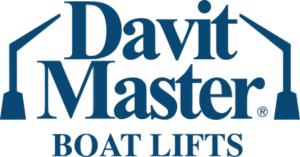
PWS offers Swinger lifts and Elevator lifts with capacities ranging from 1,500 lb to 16,000 lb.
Swinger lifts have a travel range of 8’6” and Elevator lifts have a customizable travel range.
Swinger lifts have the ability to rotate your craft 180° to move it away from the water completely.
Elevator lifts can operate at a 45° angle, making them ideal for overcoming obstacles.
Professional Assistance
PWS: Your Trusted Boat Lift Partner
Choosing the right boat lift can be complex, seeking professional assistance is recommended. PWS offers a comprehensive selection of ShoreMaster, SunStream and Davit Master boat lifts to meet your specific needs. Our experienced team can help you choose the right lift for your boat, water depth, and wave conditions.
Contact us today at (920) 493-4404 for a free consultation.
Additional Resources:
Aug 10, 2021
WHAT CAUSES SHORELINE EROSION?
Lakeshores are areas of constant dynamic energy. Powerful waves, high water, and ice move soil particles away from shorelines. In more severe cases, small pebbles and eventually rocks begin to wash out. When the water reaches far enough up the shoreline, erosion of lawns and exposing tree roots start.
We’ll try to answer some of your questions today.
What are the leading causes of shoreline erosion?
On open water like Green Bay, the three leading causes of erosions are:
-
- Wave action;
- High water; and
- Ice movement.
The ice on frozen lakes or the Bay can expand towards the shore with a force of many tons per square foot. The ice will destroy most obstacles in its path. Masses of ice put in motion by winds can push trees or buildings over, as exhibited here.
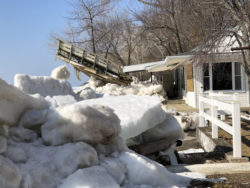
Ice vs deck erosion
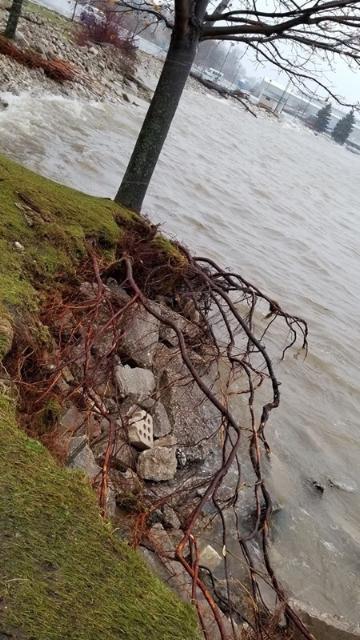
Shoreline tree roots exposed
Ice also pushes embankments, uprooting trees and lawns on small inland lakes. No matter how massive a tree is, the ice won’t slow down for it.
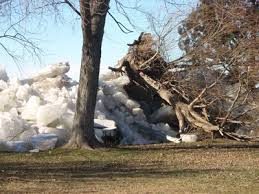
Ice Shove uprooting trees
In relatively small inland lakes, breaking waves can erode lawns away.
Headlands (points) usually have relatively high erosion rates. The waves, currents, and the ice will attack from all three sides. These attacks eventually transport the sediments to a new location where they settle in calmer weather.
Erosion is a normal process of nature.
Erosion and the redistribution of sediments is a natural process along shorelines. Typically, natural erosion proceeds very slowly. The plants and animals that live along the shore can adjust to these slow changes. They maintain a stable, healthy, productive ecosystem.
Accelerated erosion results when natural or human disturbances cause this equilibrium to be upset. Examples of this are higher than normal water levels and intense storms.
Human disturbances include vegetation removal, dredging, filling, or construction near the shoreline.
Another example of natural disturbances is large trees uprooted by a windstorm or a flood. When the soil becomes saturated with water, it weakens the soil around tree roots. The winds may uproot that tree.
IDENTIFY SERIOUS EROSION PROBLEMS
These are several signs of severe erosion problems. (Number one and three are significant)
- A large area of bare soil on a steep, high shoreline bank;
- A measurable change of the shoreline over time;
- Leaning or downed trees with exposed roots; and
- Large patches of muddy water near a lakeshore during periods of high water or following a rainstorm.
3 TYPES OF REACTIVE EROSION CONTROL METHODS:
Vegetative/No Mow: This method involves encouraging or planting trees or woody shrubs for the soil binding properties of their root systems. Grass and other plants will protect against raindrop impact and scouring from surface runoff.
Structural: This includes protective structures. The placement of rock of various sizes (rip-rap) has traditionally been the most effective and least expensive method.
Other structural methods include bulkheads, gabions (rock-filled baskets), and railroad ties. However, these methods are visually unappealing. They require more heavy equipment and technical expertise. These systems are more prone to failure than simple rip-rap. In addition, the DNR has disapproved of these methods in the past.
Manipulative: Mostly used on streams, this includes:
-
-
- Removing streamflow obstructions;
- Grading shoreline banks, or, in exceptional circumstances;
- Rerouting a stream channel.
Are there new techniques developed to prevent erosion?
A new soil preservation method called bioengineering has been proven successful.
Soil bioengineering combines mechanical, biological, and ecological concepts. These methods arrest and prevent shoreline erosion. An example is planting willows interspersed with rip-rap, where the rock provides immediate resistance to decay.
As the willows become established, roots invade and permeate the rock and underlying soil. They bind them together into an erosion-resistant mass. The willows also impart a more “natural” look to the shoreline.
Water levels are down; I don’t have to worry – Right??
This year, people do see water levels about 18-24″ less than in 2020. High water levels are the most significant contributing factor to shoreline erosion.
Will it stay down next year or in the years after? No one knows. In Las Vegas, that’s called a crapshoot.
What other factors affect my shoreline?
The next factor is the intensity of the storms. The Door County Peninsula had numerous high wind storms this year with up to 70 MPH winds.
A popular Marina in Sturgeon Bay: Skipper Bud’s Harbor Marina, located at the foot of the Michigan St. bridge, was a victim of a recent storm.
The marina had two of its five floating docks torn loose during a strong storm. Two tub boats quickly moved in place to prevent them from swinging into the bridge.
Are there other contributing factors to shoreline erosion?
You can expect water levels to rise rapidly when winds blow from the NW – NE direction for prolonged periods. This is despite the lower water levels this year. The stronger the winds, the higher the water will go. Waters south of Sturgeon Bay are particularly affected by these winds. In those areas, there are no other large outlets for the water to escape.
DO YOU NEED AN ESTIMATE FOR RIP-RAP?
Contact Dave@ 920-493-4406 or email at Dave@wisconsinpws.com.
What comes next?
Next week (on Aug 10, 2021), we will cover:
-
-
-
-
- Planning an erosion control project;
- Does erosion hurt my property values?
- What to expect for the cost of rip-rap.
Where is Pier & Waterfront Solutions?
Located at 7325 St. Hwy 57, it’s 3 miles south of Sturgeon Bay and 1 mile past the intersection of Cty MM (heading north). Look on the right side, one mile north, at the next corner (Idlewild Road and Hwy 57).
Is PWS OPEN?
The “Delta” variant is currently surging across the country.
Pier & Waterfront Solutions remains “open.” We have implemented measures to help protect the safety of our employees and visitors. PWS continues to work to maintain the trusted service that you have come to expect.
PWS implemented these preventive measures:
- Conducting as much business as possible by email, text, or phone.
- Site visits will continue.
- When in-person contacts are necessary, we follow “social distancing” guidelines.
- Our display yard is always open for you to examine at your leisure.
- All displays have a numbered, red tag on them. For more information, please reference that number.
What can YOU do to help us?
1. Conduct as much business as possible via emails, messaging, and emails.
2. When you see our crews installing equipment, please practice “social distancing.”
Thank you for allowing us to work with you.
YES – PWS is OPEN and waiting for you!
Please call, message, or email PWS with any questions.
Let’s all stay safe!
Feb 23, 2021
Ramps vs. Gangways
A frequently asked question is – what is the difference between ramps vs. gangways?
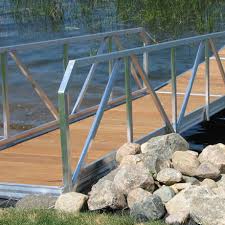
Gangways
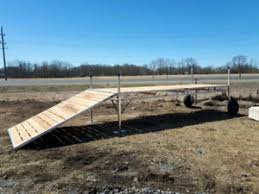
Standard dock ramps
When choosing between ramps vs. gangways, first, think about what your neighbors are using. Remember, your dock will most likely sit at the same height!
Would you, your family, or guests be comfortable going up that incline to use the dock?
Do they need a running start to get up to the dock? If they do, a ramp is not the way to go.
Ramps work great for a level or short distance up or down. They don’t need handrails due to their length, and the angle to the dock is not steep.
How high is your dock above the water?
On an inland lake, you usually are about 1 foot above the water at the most. Since the waves seldom get more than a foot high on a lake, you don’t have a steep climb to get to the dock. A simple ramp will do an excellent job for you.
One more thing to consider about a ramp
Please don’t allow yourself to be talked into using a ramps narrower than the dock itself. It’s an accident waiting to happen.
Someone walking to shore may get distracted and step off the dock expecting the ramp to be the same width. Foolish but true.
Ramps or gangways should always match the width of the dock. You don’t want someone stepping off the edge when they thought the dock was wider.
Consider your shoreline
What do you have to walk over to get to your dock? Is it a sandy beach or a rocky shore with stones the size of the palm of your hand? Are there large boulders that only the kids enjoy climbing?
Is rip-rap only is the first obstacle followed by the rocks?
Now, with the rip-rap, you may experience a difficult time getting over the rocks. In some cases, the water is right up to the rip-rap.
Once over the rip-rap, you may have to walk over some rough terrain to get to the dock or pier.
Gangways are a safe and straightforward solution to your problem.
Consider both the length and width you need. For example, the PWS 3-Season Pier offers various pier and ramp widths and lengths to fit your needs.
PWS offers ramps and gangways with the same decking as the rest of your dock. It all fits together seamlessly.
Do you have rip-rap?
Due to the high water, you may have installed rip-rap along the shoreline to protect property values.
Now, with the large rip rap, you may have a difficult time getting over the rocks.
You may also have to walk over some rough terrain to get to a dock or pier.
What’s the solution?
To start with, PWS can add stairs in the form of flat rocks or steel steps right in the rip-rap. From there, we have gangways in 20 ft. lengths to finish your walk over any obstructions.
Have an aluminum dock?
PWS has 16′, 20′, and 24′ lengths with handrails included. These significantly reduce the chance of a twisted ankle or a broken leg or arm.
No rip-rap?
The high water likely means your dock is higher than previous years to escape the waves’ power in a storm.
Now you need ramps or gangways to access the dock. A ramp, which is usually 8-10′ long, will give you a steep angle to climb under some circumstances.
The best way to access your dock when it is this high is via gangways. The longer gangways provide a gradual slope that young and old will appreciate.
A gentle transition from the shoreline to your dock is essential for a seamless, gentle climb. (As a side note, the long gangways mean you usually need fewer sections of the pier.)
PWS offers stairs, ramps, and gangways to access your dock.
One of the critical choices you’ll make is choosing between ramps and gangways.
What do you have to walk over to get to your dock?
What do you have to walk over to get to your dock – Sand, rocks, or boulders?
As you think about the length, make sure you keep in mind the ramp’s width. PWS has various options to suit your needs.
Ramps
If you don’t have far to walk (less than eight feet from shore to dock), a ramp is an excellent choice. That is unless the pier is set high.
Ramps are standard on shorelines where the water level doesn’t fluctuate much. The ramp is usually short enough that they don’t require handrails. However, longer approaches provide a gentle slope to a higher dock.
Aluminum Ramps come in 4′ x 4′, 4′ x 8′, and 6′ x 8′ sizes. The strength of aluminum does not normally allow for longer lengths without handrails.
PWS will advise you which type of dock access works best in your situation.
Gangways
If the distance from your dock to the shore is:
1. Long and you have to walk over large rocks or boulders:
2. The dock is set high: or
3. You get a lot of debris floating along your shoreline – Consider gangways rather than ramps.
Unlike ramps, gangways provide a gentle slope to walk up because of the distance they cover.
A 20′ gangway could reduce the cost of your dock system too.
Aluminum Gangways
Aluminum residential gangways are 4′ wide and come in lengths of 16′, 20′, and 24′.
An alternative for galvanized docks would be a steel gangway, which comes in 20′ lengths. As you can imagine, this longer length is much more comfortable with less incline.
Let’s summarize these ideas.
Let PWS find the Perfect Dock System for you.
Determining what a good fit would be is an integral part of making your dock system perfect.
PWS offers high-quality and affordable options for gangways, ramps, and accessories. We provide the expertise and expert knowledge you need to determine which option will work best for your situation.
PWS can help you plan the perfect boat docking system for your area.
Get started HERE!
Where is Pier & Waterfront Solutions?
Pier & Waterfront Solutions, 7325 St. Hwy 57, is located 3 miles south of Sturgeon Bay. It’s 1 mile PAST the intersection with County road MM (heading north). Look on the right at the intersection of Idlewild Road and Hwy 57.
ARE WE OPEN?
Pier & Waterfront Solutions remains “open” year-round.
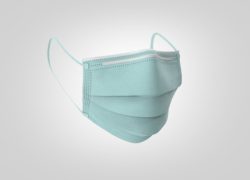
Please use face masks
The virus continues to spread. PWS is conducting as much business as possible by email, text, or phone.
Site visits continue as usual. When making in-person contacts, we follow “social distancing” guidelines whenever possible.
Our display yard is OPEN 24-7
The PWS display area is always open for you to examine at your leisure. All displays available for sale have a numbered, red tag on them. Want more information on something you saw in our yard? Please reference that number when you inquire.
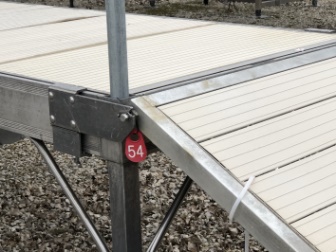
Red Tag
PWS will provide estimates by email to make the process faster, safer, and paperless.
Call, message, or email us with any questions.
Thank you for allowing us to work with you.
Aug 4, 2020
Why does my Dock Move?
Movement or ” dock sway” is the result of deeper water. Due to the deep water and stronger storms, it is necessary to raise your dock to protect your equipment. And it’s even higher than last year.
HOW CAN THE MOVEMENT BE MINIMIZED?
Before we can answer that question, there’s an important question you must answer. HOW is the dock moving?
The question seems simple enough. But, we need to distinguish between vertical movement and horizontal movement. These have different symptoms, and both have different solutions.
Vertical movement gives you a “spongy” bounce as you walk on the deck. As you may have noticed, the sensation is more noticeable when you walk near a dock leg.
VERTICAL MOVEMENT (BOUNCE) HAS TWO POSSIBLE CAUSES:
1. A leg is no longer in contact with the lake bottom; or
2. Loose bolts on the dock frame in the leg pockets.
Usually, you will sense the bounce in one area along the dock length. The problem should affect only one side of the dock.
How does this happen, and what can I do?
The simplest way to check for the cause is to check the bolts that lock the legs. Are the bolts loose in the affected area?
If the bolts are tight on the dock legs, the problem is at the bottom of the legs. It’s rare, but occasionally one of them is not touching the bottom.
On a sandy bottom?
If you are in a sandy area, the water may have washed the sand out from under the footpads. If this is the case, the legs need adjustment.
While standing in the water, loosen both bolts on only the affected leg. Move the dock frame-up. When you loosen the bolts, the legs will fall until the footpads hit bottom. Now, push up on the dock frame and tighten one bolt and then the second bolt.
Try to “wiggle” the legs around and re-tighten the bolts, if needed.
It is not uncommon for storms to “wash out” the sand from under the footpads. Even with a properly installed dock, a storm can move the sand at any time.
There is no way to prevent this from happening. It’s a natural phenomenon. The next storm could leave the same leg pad buried under 6″ of sand.
What if I have a rocky bottom?
Like the sand beach, a storm may “wash out” smaller rocks under the footpads. Once the stones move away from the leg, the leg has nothing supporting it.
Why does the dock move up?
If a wave makes contact with the bottom of any solid decking, it will push the dock up – momentarily. When the dock frame goes up, it takes the legs with it, allowing the wave to move the rocks around under it.
We recommend the open style of decking to minimize vertical dock movement. See This Article.
What if the movement is side-to-side (sway)?
Dock “sway” results when a dock is raised high out of the water. The height determines how much sway you experience.
By raising the dock, the center of gravity is elevated. When you experience high water, we must raise the dock to minimize damage during storms.
At the same time, increasing the dock height brings a problem with it. The pier is now less stable because the center of gravity is higher.
Think of it this way – If you are on a 6 – step ladder, the first few rungs are stable. The higher you go – not so much. Place your feet on the top of the ladder, and it’s precarious.
What can we do to minimize sway?
The only thing that we can do is to add cross-braces. Cross braces will eliminate, or at the very least, cut down on the swaying.
What are cross braces? They are pipe(s) attached at an angle to the legs of the dock. One end is near the bottom and the other end is under the frames and near the top of another leg. For the structure to move sideways, it must also move the opposite leg at the base where it is firm.
What does PWS do on the new 3-Season Pier?
The new pier uses 2″ schedule 40, steel pipe, which is approximately 2 3/8″ O.D. (Compare that with the legs used by some competitors – 1 1/4 pipes or 1 1/2″ tubing. Both of these have virtually no strength and should never be used on a dock.)
One final suggestion
We recommend the open style of decking to minimize vertical dock movement. The “Flow-Through” decking, which is standard on the 3-Season Pier, reduces the effect of the waves on the dock. With 42% less deck surface, they allow the wave to pass through the decking and minimizes the pressure from the waves. Less chance of the dock being “lifted” or rolled over.
What to look forward to in 2021
2017-2020 saw high water after years of decline in water depth. As a result, many people decided not to install all the sections. They had plenty of water even with a shorter dock.
It’s too soon to tell what 2021 will mean for water levels. Early indications are it will be close to 2020 or even higher as the year progresses. To get the latest information on lake levels, follow this link:
http://www.lre.usace.army.mil/Missions/Great-Lakes-Information/Great-Lakes-Water-Levels/Water-Level-Forecast/Monthly-Bulletin-of-Great-Lakes-Water-Levels/
Look for the Lake Michigan-Huron charts.
For more information on sway bars or Flow-through decking, contact Jerry @ (920) 493-4404 TODAY – or – fill out this simple quote request FORM.
WHERE IS PIER & WATERFRONT SOLUTIONS?
Located at 7325 St. Hwy 57, it’s 3 miles south of Sturgeon Bay, and 1 mile past the intersection of Cty MM (heading north). Look on the right side at the intersection of Idlewild Road and Hwy 57.
ARE WE OPEN?
Pier & Waterfront Solutions has remained “open.” We have implemented measures to ensure the safety of our employees and visitors. At the same time, we are working to maintain the trusted service you expect.
We are conducting as much business as possible by email, text, or phone. Site visits will continue as usual. When in-person contacts are necessary, we follow “social distancing” guidelines as closely as possible.
YARD DISPLAY – WHAT IF I SEE SOMETHING I WANT?
Our display yard is always open for you to examine at your leisure. All displays that are available for purchases have a numbered, red tag on them. If you want more information or pricing, please reference that number.
We provide estimates and invoices by email to make the process faster. With these measures, we hope everyone will stay safe, and we will be back to normal operations soon.
Call, message, or email us with any questions.
Thank you for allowing us to work with you safely.
Let’s all stay safe!
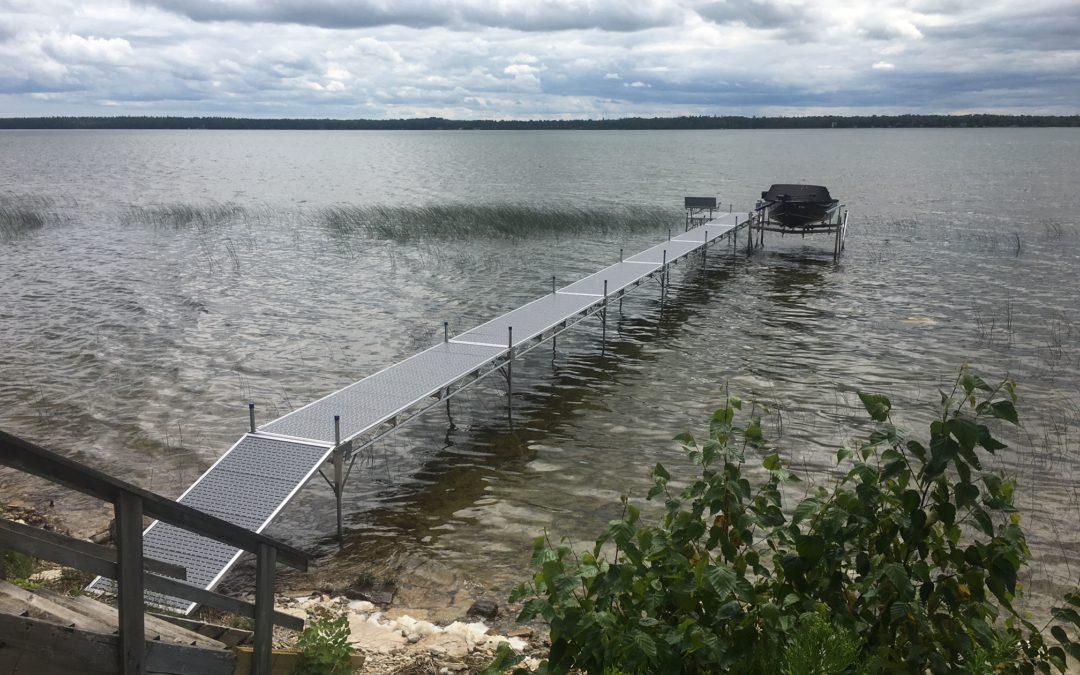
Apr 28, 2020
3 REASONS FOR A SHORTER DOCK
The high water again this year means that your dock and boat lift will once again be taking a beating. (see article)
Last year, some people insisted on putting their entire dock in. Additionally, they wanted their boat lifts at the end of the dock. We advised against this, and we will be asking again this year. Why do we recommend this?
THE LEGAL REASON
First, the Legal reason – the DNR restricts a dock from being in water depths deeper than necessary to float a boat. In the past, in some areas, this meant a dock could be 200′ long (with warning lights to alert boaters in the dark).
Even that 200′ dock was legal as long as it did not obstruct boat traffic. If the water levels were shallow, you had to go that far out to launch a boat in some areas.
Today, that same dock could be closer to 100′ (or less) due to the extremely high water.
NOW – THE PRACTICAL REASON
Second, the reason for a shorter dock this year is simple – The water is EVEN HIGHER this year. There is a better chance that your dock and boat will survive the storms.
NEXT, THE FINANCIAL REASON
Finally, do you want to save money as well as reduce the risk of damage to your dock & boat lifts? The cost of installation depends, among other things, on the actual time it takes to install your equipment. Often, fewer sections equate to lower costs.
What’s the alternative to a shorter dock?
Without your agreement, we had to install the full length. If you didn’t agree, we felt we had no choice but to replace the legs with longer legs. We had to do this to compensate for the higher water. But, this route results in higher costs for installation.
Some homeowners took us up on the shorter docks in the hope that the water would go down in 2020. It didn’t! Others opted for lengthening the legs.
From our standpoint, it requires more time to replace the legs with longer ones than to shorten the dock.
So – What Happened?
Some docks did not have longer legs put on, and we installed the entire length. Still, they survived. If this was your dock, feel fortunate.
For those who did NOT allow us to do one of these alternatives, we will be asking you to choose again this year. Remember, the water is even higher this year.
We would prefer to leave one or two sections uninstalled this year. The alternative, we will request that you allow us to put longer legs on your dock. Our goal is simple – we want to limit damage to your dock.
Also remember, with longer legs, your dock may have more “sway” to it. If that happens, we recommend sway braces.
Even with longer legs, we will ask you to move your boat, and jet ski lifts closer to the shore. This will help protect them from the waves. The lifts have limited leg lengths (without getting longer legs). Your boat could pay the price if we don’t use one of these alternatives.
NEW – this year!
This year PWS has another alternative that was not available in the past. Talk to Jerry about trading your dock for the new 3-Season Pier, which we are now offering.
This new steel dock can handle storms better due to it’s greater weight and the “open” decking we use. Combining these two features makes it the heaviest pier on Green Bay. It has survived installations on Lake Michigan also.
Tell Your Friends & Family
Have friends or neighbors you believe should see this article? Email them this link – and Thank you!
Don’t Forget – Considering rip-rap for your shoreline? PWS is the place to contact!
PWS is open for business as usual. Practicing “Social Distancing”? We do business by phone and emails also.
Where is Pier & Waterfront Solutions?
Located at 7325 St. Hwy 57, it’s 3 miles south of Sturgeon Bay, and 1 mile past the intersection of Cty MM (heading north). Look on the right side, one mile north, at the next intersection (Idlewild Road and Hwy 57).
ARE WE OPEN?
During this time of uncertainty, Pier & Waterfront Solutions is staying “open.” We have implemented measures to ensure the safety of our employees and visitors. At the same time, we are working to maintain the trusted service that you have come to expect.
We are implementing these precautionary measures:
1. Conducting as much business as possible by email, text, or phone.
2. Site visits will continue but with limited in-person meetings. When in-person contacts are necessary, we will follow “social distancing” guidelines.
3. Our display yard is always open for you to examine at your leisure. All displays have a numbered, red tag on them. If you want more information or pricing, please reference that number.
Is there More?
4. Some employees will be working remotely, but they are always available by phone.
5. Any employee with symptoms or illness is sent home.
6. We continue to provide estimates and invoices by email to make the process paperless.
7. Crew starting times are being staggered to limit social interactions.
8. We keep the same crews together to limit cross interactions.
With these measures, we hope everyone will stay safe, and we will be back to normal operations soon.
What can you do to help us?
1. Please conduct as much business as possible via emails, messaging, and emails. This step protects everyone involved.
2. When you see our crews installing equipment, please practice “social distancing.”
Thank you for allowing us to work with you.
So – YES – ARE WE OPEN?
Please call, message, or email us with any questions.
Let’s all stay safe!
Contact:
Jerry @ (920) 493-4404 or Jerry@wisconsinpws.com – Commercial work & new/used Sales.
Dave @ (920) 905-2588 or Dave@wisconsinpws.com – Erosion control & shoreline work.
John @ (920) 493-4405 or John@wisconsinpws.com – Scheduling & Service work
















